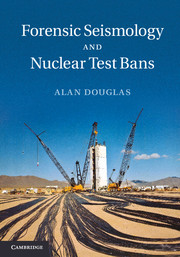Book contents
- Frontmatter
- Contents
- Preface
- Abbreviations and mathematical symbols
- Prologue
- 1 Seismology: ancient and modern
- 2 Statistical solutions to seismological problems
- 3 Seismograms as time series
- 4 Seismographs and seismograms
- 5 Seismometer arrays and processing methods
- 6 Seismogram interpretation and synthesis
- 7 Hypocentres and P travel times
- 8 Seismic magnitudes
- 9 Seismic source identification
- 10 Epilogue
- Appendix A P and S radiation from a double-couple source
- Appendix B Normal equations for analysis of variance
- Appendix C Some uses of the FFT
- Appendix D Anelastic attenuation
- Appendix E The relation of the transient and steady-state responses
- Appendix F Seismometer–galvanometer systems
- Appendix G SNI from summing array recordings
- Appendix H The equations for computing MP filters
- Appendix I Circular arrays
- Appendix J Geometrical spreading when S reflects as sP
- Appendix K The Fourier integral for a dispersed wave train
- Appendix L Tables of explosions and earthquakes
- Appendix M Album of body-wave seismograms
- Appendix N Exercises
- References
- Further reading
- Author index
- Index
6 - Seismogram interpretation and synthesis
Published online by Cambridge University Press: 05 March 2013
- Frontmatter
- Contents
- Preface
- Abbreviations and mathematical symbols
- Prologue
- 1 Seismology: ancient and modern
- 2 Statistical solutions to seismological problems
- 3 Seismograms as time series
- 4 Seismographs and seismograms
- 5 Seismometer arrays and processing methods
- 6 Seismogram interpretation and synthesis
- 7 Hypocentres and P travel times
- 8 Seismic magnitudes
- 9 Seismic source identification
- 10 Epilogue
- Appendix A P and S radiation from a double-couple source
- Appendix B Normal equations for analysis of variance
- Appendix C Some uses of the FFT
- Appendix D Anelastic attenuation
- Appendix E The relation of the transient and steady-state responses
- Appendix F Seismometer–galvanometer systems
- Appendix G SNI from summing array recordings
- Appendix H The equations for computing MP filters
- Appendix I Circular arrays
- Appendix J Geometrical spreading when S reflects as sP
- Appendix K The Fourier integral for a dispersed wave train
- Appendix L Tables of explosions and earthquakes
- Appendix M Album of body-wave seismograms
- Appendix N Exercises
- References
- Further reading
- Author index
- Index
Summary
In theory there is no difference between theory and practice. In practice there is.
Yogi Berra (2012)Introduction
When the arrays came into routine operation the focus of research shifted from the design of the arrays and the recording systems to the analysis and interpretation of the SP body-wave (principally P) seismograms. With such high-quality recordings (on which local effects are suppressed) with the flexibility to change the playout speeds and magnification, routine analysis (the measurement of times, polarities, A and T) could be carried out with less error than on conventional paper and photographic recordings. The development of ways of increasing the bandwidth of SP recordings and correcting for the effects of attenuation further improved methods of analysis. But, whereas such improvements are valuable, there had to be more that could be learnt from array seismograms than this; and this proved to be so, for with the aid of the programs to synthesize seismograms, progress began to be made with the detailed interpretation of array recordings. An hypothesis about some feature of a seismogram could be tested by setting up the appropriate model and comparing the synthetic seismogram with the observed one. Synthesizing seismograms can also be used to explore the effects of variation in source and Earth models to answer the question ‘What would be the effect of…?’.
- Type
- Chapter
- Information
- Forensic Seismology and Nuclear Test Bans , pp. 220 - 277Publisher: Cambridge University PressPrint publication year: 2013



